Best funayuki knives | Japanese fish cutting favorite [top 5 reviewed]
Japanese fishermen use a funayuki knife to cut, slice, and test the fish they catch right there on the boat – this way they can save time and avoid a bad catch or bad batch of fish.
They also use the same knife to cut bread, veggies, and fruit for their breakfast or dinner aboard the fishing vessel.
The funayuki is one of the less popular Japanese-style knives because not as many people are processing fish as other types of meat like chicken, for example.
![Best funayuki knives | Japanese fish cutting favorite [top 5 reviewed]](https://www.bitemybun.com/wp-content/uploads/2022/04/Best-funayuki-knives-Japanese-fish-cutting-favorite-top-5-reviewed.png)
The funayuki knife encompasses several types of fish knives, but for all your cutting, cleaning, and slicing needs, the MOTOKANE HONMAMON Funayuki Hocho does the job. It has a double bevel blade so it’s easy to use regardless of how good your Japanese knife skills are.
In this guide, I’m reviewing the best funayuki knives so you can make all your favorite seafood dishes at home or if you’re a chef these knives will make your life easier.
First, check out the table with the best products and then read the full reviews below:
| Best funayuki knives | Images |
|---|---|
| Best funayuki overall & most versatile: MOTOKANE HONMAMON Funayuki Hocho | 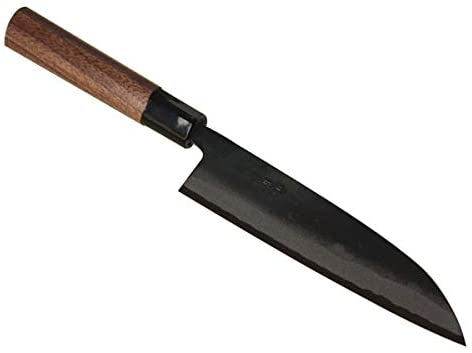
|
| Best budget funayuki: Kai Kitchen 8″ Chef’s knife | 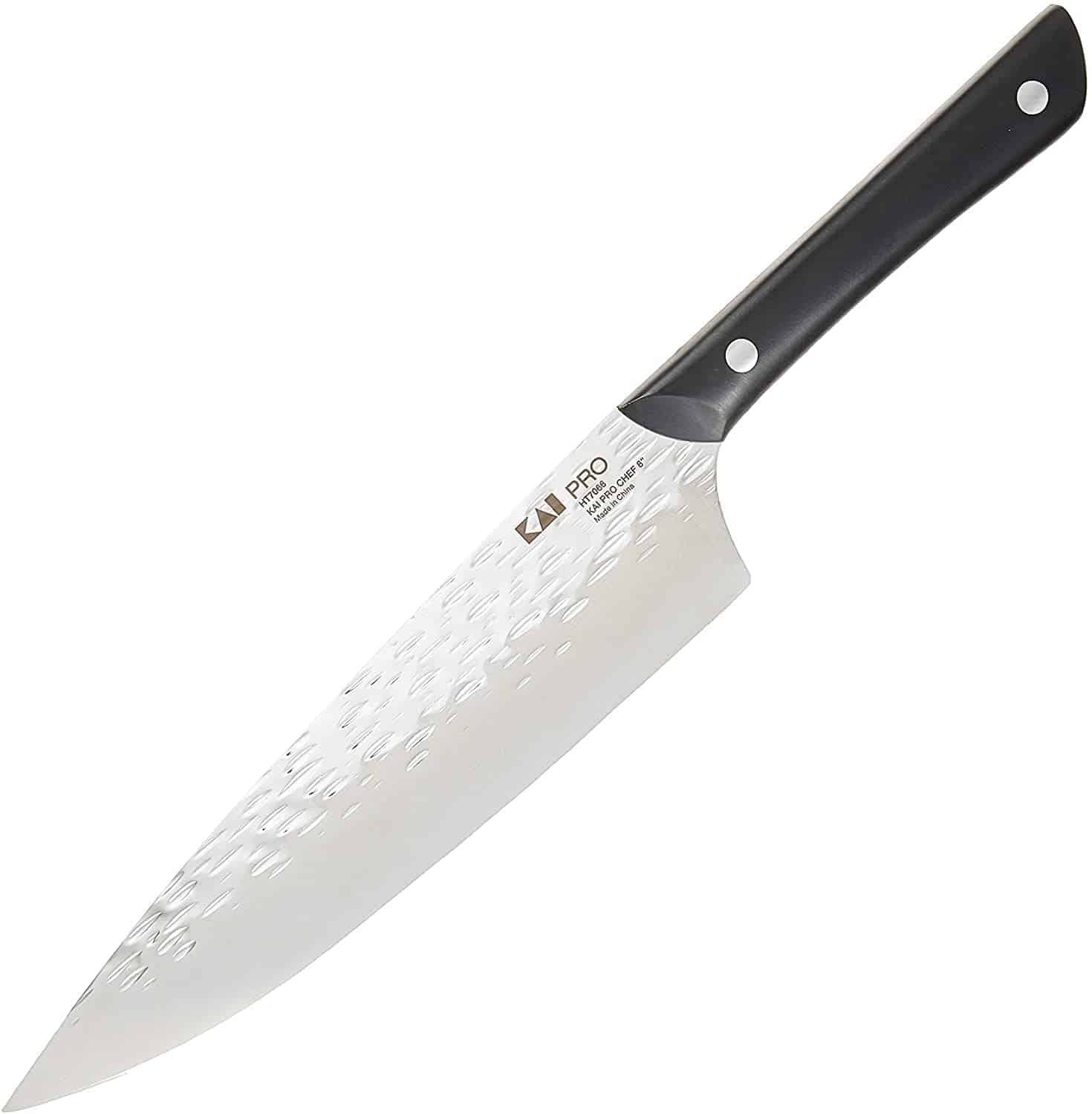
|
| Best single bevel funayuki: Kanetsune Funayuki-Deba | 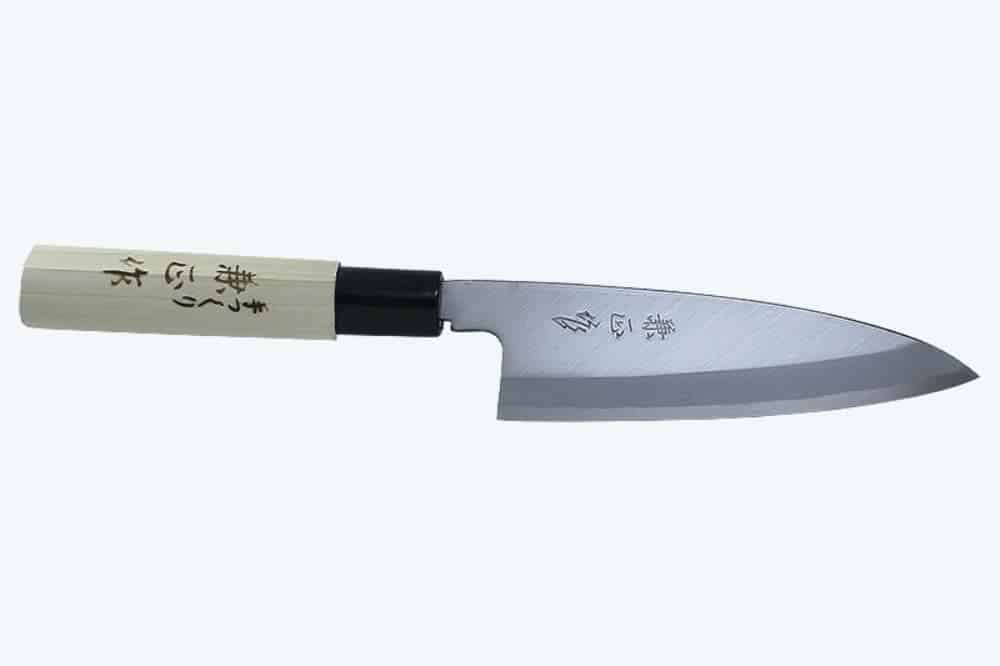
|
| Best small funayuki knife & best for sushi: MOTOKANE HONMAMON 5.9 inch | 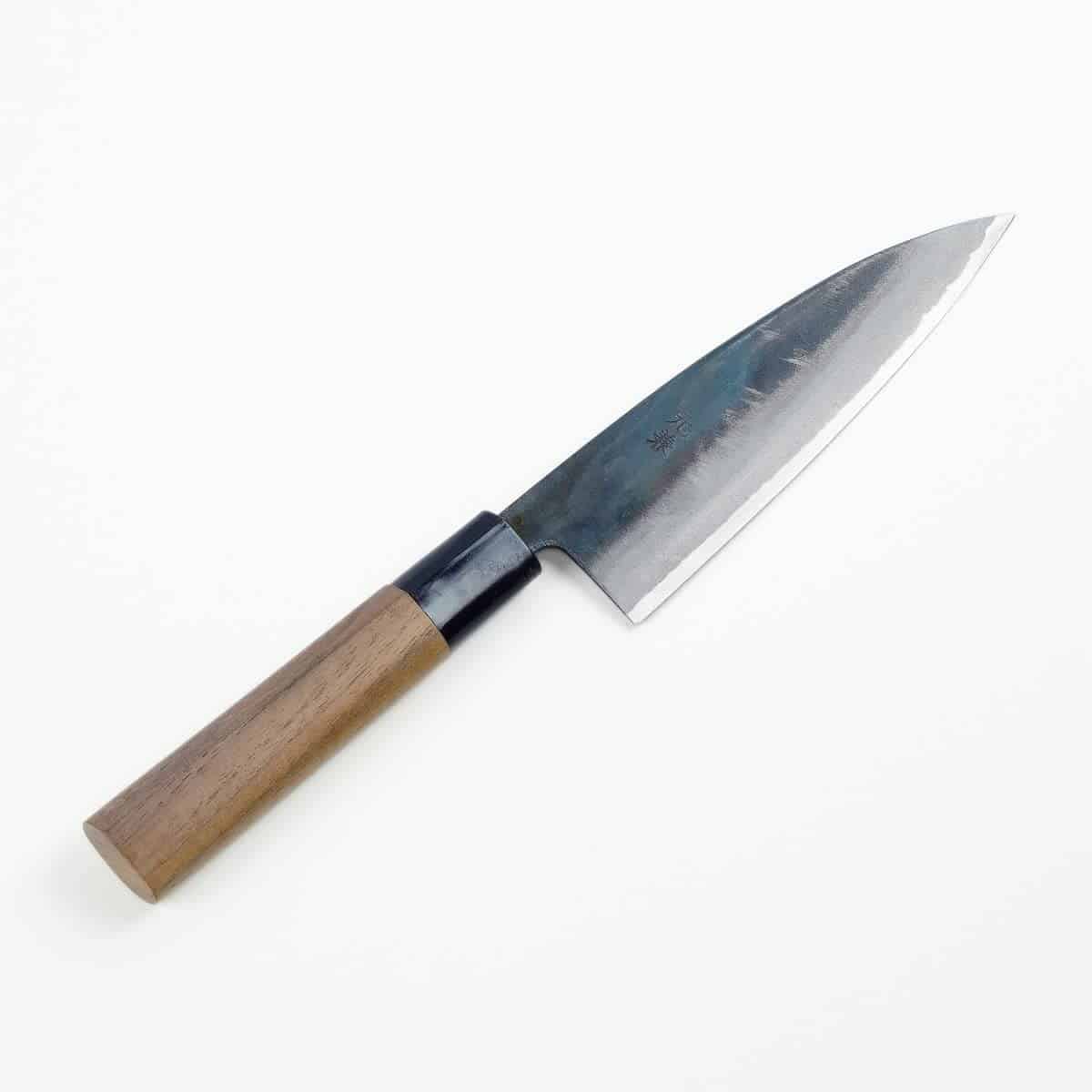
|
| Best kiritsuke funayuki: TUO Kiritsuke Knife | 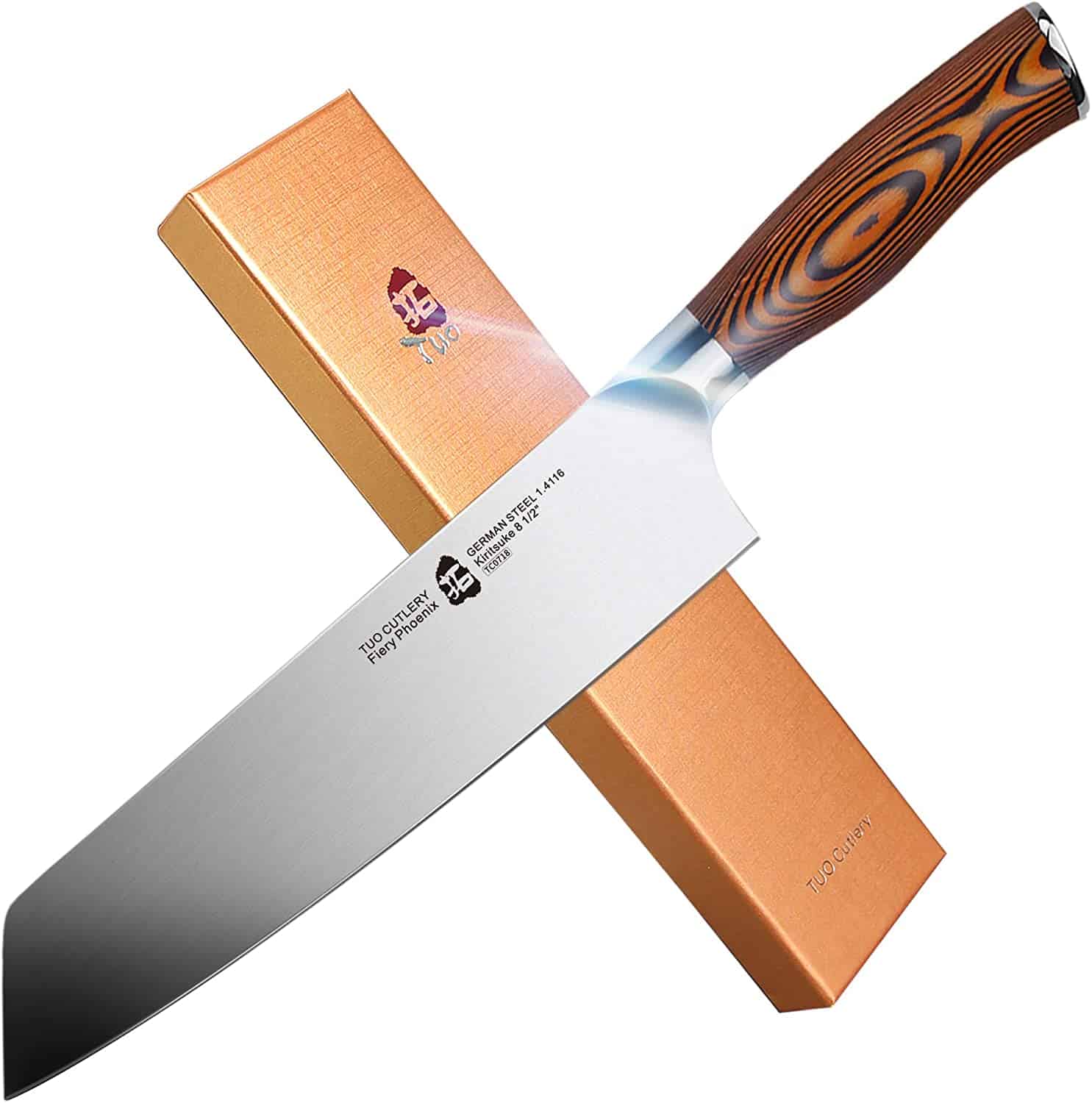
|

Check out our new cookbook
Bitemybun's family recipes with complete meal planner and recipe guide.
Try it out for free with Kindle Unlimited:
Read for freeIn this post we'll cover:
- 1 Buyer’s guide
- 2 Best funayuki knife reviews
- 2.1 Best funayuki overall & most versatile: MOTOKANE HONMAMON Funayuki Hocho
- 2.2 Best budget funayuki: Kai Kitchen 8″ Chef’s knife
- 2.3 Best single bevel funayuki: Kanetsune Funayuki-Deba
- 2.4 Best small funayuki knife & best for sushi: MOTOKANE HONMAMON 5.9 inch
- 2.5 Best kiritsuke funayuki: TUO Kiritsuke Knife
- 3 Takeaway
Buyer’s guide
When looking for a funayuki knife, it is important to consider the type of blade and the design of the knife.
Chances are you won’t be using the funayuki aboard fishing boats so you need them to be functional in the home kitchen or restaurant.
Most traditional Japanese knives are versatile and the funayuki is also suitable for more than one task.
Here are the features you should consider before buying a funayuki knife:
Blade length
The blade should be the right size and shape for the intended use.
For example, a yanagi-funayuki is designed for slicing meat and fish, so it has a long, thin blade. A usuba-funayuki is designed for chopping vegetables too, so it has a short, curved blade.
The blades of most funayuki knives like the Yanagiba knife come in a variety of lengths. 6.5 to 9 inches are the most common blade lengths.
Choosing the right length of blade depends on your personal preferences. Choosing a knife that is easy to handle requires a blade that is shorter in length.
When it comes to larger cutting tasks, I’d recommend a knife with a longer blade.
Blade material
This is one of the most critical aspects of the knife’s construction.
It is well-known that the steel used in Japanese knives is exceptionally strong and sharp with long-lasting edges and a high level of quality and ease in sharpening them.
High-carbon steel (also known as blue or white steel) at the most expensive end of the spectrum, on the other hand, is extremely hard and requires a lot of upkeep but it’s one of the best cutting blades available.
The most common type of Japanese knife you’ll be looking for is a high carbon or regular stainless steel model.
VG-10 steel blades are also really good value because the blades stay sharp and don’t chip easily.
Knives made of stainless steel last longer and are less likely to rust, so investing in a more expensive knife isn’t necessary if you’re just getting started with your Japanese knife collection.
Keep your Japanese knives sharp by storing them the right way (Japanese knife stands reviewed)
Handle material
In terms of handle material, the traditional material is rosewood or magnolia wood. But all wooden handles are pretty good but they can get a bit moldy and require extra care.
These knives typically have handles made of wood, plastic, or metal. Most traditional and best for grip, wood handles are an excellent choice for your next project.
Plastic is a common material too which is not only lightweight but also incredibly comfortable to hold in the hand.
Metal handles are less common, but they are the most durable.
Again, it’s critical to pick a handle material based on your preferences and requirements. I’d recommend a wood handle if you want a more traditional knife.
With that being said, if you’re looking for something more durable than a plastic or wood handle, I’d go with something like a metal or rubber handle, especially if you’re going to be on the boat in humid conditions.
Handle type
Depending on how the knife is balanced and how it feels in your hand, the shape of the handle is extremely important.
When it comes to using a knife, it’s imperative that you have a good handle on it so that you don’t injure yourself.
Make sure the handle isn’t too big or too small for your hands before making a purchase, as they will be more difficult to control if they are too large or too small.
Usually, Wa handles have a round or octagonal shape and it takes a bit of getting used to them.
Bevel
Traditionally, Japanese knives are single beveled meaning that the knife has a concave grind on one side and a convex grind on the other.
This makes it easier to sharpen and gives you more precise control over the blade.
Western-style knives are double beveled, which means that the grind is even on both sides of the blade.
This style is easier to find and is more popular in the Western world.
With the funayuki knife, you can use either type of bevel. If you’re left-handed be sure to get a double-bevel knife because then you can use it too.
Single-bevel blades are designed for right-handed users unless you find the “leftie” version but it’s almost impossible to find that for a funayuki knife these days.
Best funayuki knife reviews
These are the top funayuki knives to choose from.
Best funayuki overall & most versatile: MOTOKANE HONMAMON Funayuki Hocho

- blade length: 6.5 inches
- blade material: aogami steel
- bevel: double-bevel
- handle: wood
This Motokane Funayuki Hocho Japanese knife is the best all-around funayuki knife that I’ve tested. It’s well-balanced with a great grip and has a razor-sharp edge that is still easy to keep sharp.
The 8.5-inch blade is perfect for most tasks and can handle everything from precision slicing to heavier chopping tasks with ease.
Chefs use the Motokany funayuki to fillet fish for sushi, carve meats and poultry, and even perform light vegetable prep.
The knife is also well-suited for those who like to do a little bit of everything in the kitchen.
Since this is a double-bevel knife, both left and right-handed users can use it confidently.
The blade is made of aogami steel, which is high-quality stainless steel that is known for its durability and sharpness.
The knife also features a hand-forged Hamon line, which gives it an attractive and unique appearance.
This knife handle is made of wood and has the traditional octagonal shape that is common on Japanese knives. It fits comfortably in the hand and provides a great grip, even when wet.
This knife has a great reputation for quality and durability, and users can definitely attest to that.
Even after using it for over six months, it’s still going strong and the blade is in excellent shape. That’s because the blade doesn’t chip or crack and the knife holds its edge really well.
Motokane brand knives are handmade in Japan, so you can be sure that a lot of care and attention goes into crafting each one.
They’re compared to Kotai knives which are catered to Western consumers looking for Japanese-style cutlery. However, the Motokane funayuki is the real deal and sold at a great price.
If you’re looking for the best all-around funayuki knife, then the MOTOKANE HONMAMON Funayuki is it.
Best budget funayuki: Kai Kitchen 8″ Chef’s knife

- blade length: 8 inches
- blade material: AUS 6M steel
- bevel: double-bevel
- handle: plastic
While this Kai knife isn’t labeled as a funayuki knife, it has the most similar shape to the Motokane knife, except it’s much cheaper.
Therefore, it’s a great purchase if you want to save money on your Japanese knife.
The blade is made of AUS 6M stainless steel, which is still a high-quality material. It’s not as good as the aogami steel, but it will still hold its edge well and won’t chip or crack.
The finish on the blade is quite good also not as high-quality as a Shun, for example. You can expect minor rust spots after extended use.
The knife has a double-bevel, so it can be used by both left and right-handed users and it’s isn’t very sensitive. It’s also well-balanced and comfy to hold.
The plastic handle is comfortable to hold and has a nice grip, even when wet.
This knife is a great value for the price and is perfect for those who are just starting out with Japanese knives.
One problem is that the curve of the blade isn’t as smooth as that of a more expensive knife.
Also, when you slice fish into fillets, they aren’t quite as smooth. But, funayuki knives are supposed to be versatile, so this knife can do most tasks pretty well.
The Kai chef’s knife is excellent for trimming the fat from brisket and fatty beef but it’s also great for removing the fat from fish. The 8-inch blade is also great for slicing and dicing vegetables.
If you’re looking for an affordable funayuki knife that still offers good quality, then the Kai Kitchen 8″ Chef is versatile and multi-purpose.
Motokane best overall vs Kai budget funayuki
Both knives are double-beveled but the difference between them is the steel quality. The Motokane knife is made of superior aogami steel which holds its edge better and is sharper than the Kai knife.
The handles are very different – the cheaper knife has a plastic handle that is easy to clean but not as long-lasting as the traditional octagonal wooden handle of the Motokane knife.
The Motokane HONMAMON Funayuki knife is the best overall funayuki knife. It’s made of aogami steel, has a hand-forged Hamon line, and fits comfortably in the hand.
The octagonal handle is also made of wood and it’s what you’d call a traditional fish knife.
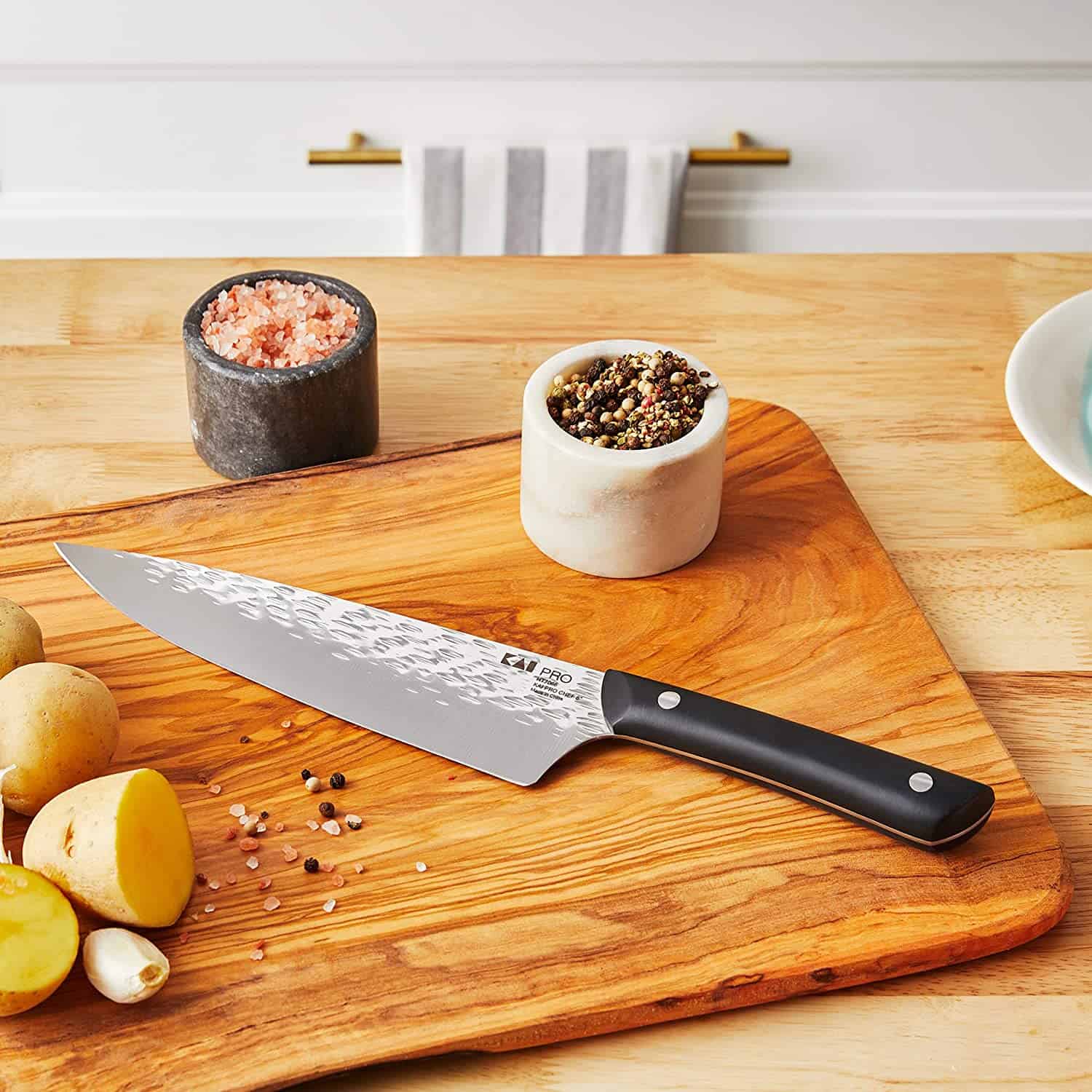
The Kai Kitchen 8″ Chef’s knife is a great funayuki knife for those who are looking to save money.
It’s made of AUS 6M stainless steel, has a double-bevel, and is well-balanced and comfy to hold. It can be used by both left and right-handed users and is excellent for slicing up the fish for sushi (like these types) and sashimi.
Let’s also talk about the different blade sizes: the Motokane knife is only 6.5 inches long which makes it better for cutting, gutting, cleaning, and filleting a fish right on the spot.
Since the blade is shorter, you can even start to de-bone it without ripping the flesh.
Since the tip is curvy, you can really get close to the bone and work to make smooth cuts. If you like perfectly cut fish for sashimi, this is the knife for it.
The Kai knife also has a curved tip but it’s bulkier and not as good for precision cuts.
Best single bevel funayuki: Kanetsune Funayuki-Deba
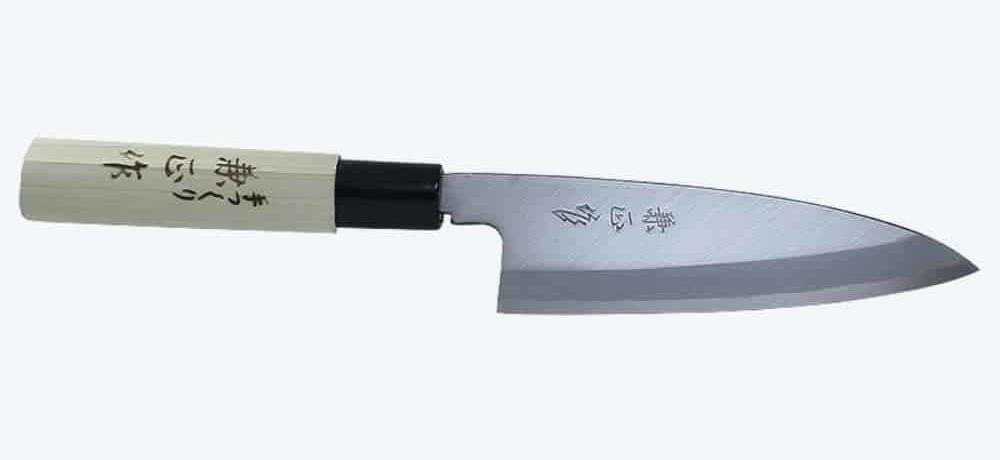
- blade length: 6.5 inches
- blade material: white steel
- bevel: single-bevel
- handle: magnolia wood
The advantage of a single-bevel funayuki deba knife is that it’s very sharp and can easily cut through fish bones.
The Kanetsune Funayuki-Deba knife is a great example of this type of knife. It’s made of white steel and has a blade length of 6.5 inches.
White steel is a high-quality material that is resistant to rust and corrosion.
The knife is also hand-sharpened to a razor’s edge, making it the perfect tool for cutting through small fish bones, filleting, slicing fresh fish, and also chopping up fruit and vegetables to cook a full meal.
Learn more about the traditional Japanese knife skills and techniques here
Compared to the regular deba knife, this funayuki knife has a thicker blade which makes it more versatile. You can cut pretty much anything with it, even though it’s more of a fishing boat knife.
This knife’s handle is made of magnolia wood which makes it solid but also offers a good grip for the user.
It does have a plastic bolster though which isn’t ideal because some say it makes the knife flimsier than some others.
Kanetsune is a knife manufacturer based in Seki City, Japan. Seki City is known as the “City of Knives” and is home to many famous blade-making companies.
Kanetsune is one of these companies, and they are well-known for their high-quality knives.
All of Kanetsune’s knives are handmade in Japan, and each one is crafted with care. The blades are made of high-quality stainless steel, and they are hand-sharpened to a razor’s edge.
This makes them not only beautiful to look at, but also great for use. The brand is well-known for making high-quality knives and this Funayuki-Deba knife is no exception.
If you’re looking for a great single beveled funayuki knife, then the Kanetsune is an excellent option.
Best small funayuki knife & best for sushi: MOTOKANE HONMAMON 5.9 inch

- blade length: 5.9 inches
- blade material: aogami steel
- bevel: double-bevel
- handle: wood
This knife is extremely similar to the best overall Motokane knife but that one has a 6.5-inch blade whereas this one is shorter at 5.9 inches.
The advantage of a shorter blade and smaller knife is that it’s lighter.
Therefore, it’s also a good sushi knife. You can still use it to cut, filet, slice, and clean smaller fish, but you can also use it to cut meat, vegetables, and fruit. It’s a great multipurpose knife.
It’s handmade in Japan with a high-quality stainless steel blade and is hand-sharpened to a razor’s edge.
Again, like the first Motokane knife, this one is also made of aogami steel. It’s also double-beveled and has a wooden handle.
The handle is also made of wood and has a traditional D-shaped design that fits well in the hand for optimum control.
However, some users say that this handle is not as comfy as a Shun, for example. You need to get used to holding it before you can really show off your Japanese knife skills.
Perhaps a chef will be much more used to the D-shaped wooden handle than a beginner.
When you look at it, the knife has a rough finish – but that’s a good thing actually because it indicates that it’s handmade by skilled craftsmen.
Most people who get this knife feel that it replaces the need for a deba or yanagiba in most cases. It’s really good sushi and sashimi knife even though it has a short blade.
Check prices and availability here
Kanetsune single-bevel vs short Motokane knife
The first notable difference between these two knives is their beveling. The Kanetsune is a single-bevel knife while the Motokane has a double-bevel.
The Kanetsune is also made of aogami steel, making it a high-quality blade, but it’s 6.5 inches long whereas the Motokane is 5.9 inches long.
The Motokane is also a handmade knife that is made in Japan with a high-quality stainless steel blade. It’s hand-sharpened to a razor’s edge and has a D-shaped wooden handle.
Both knives have a rough finish which is indicative that they’re crafted in small batches – this is a sign of good quality.
I want to mention the difference in the handles. The Kanetsune knife has a wood handle with a plastic bolster – this is more prone to damage and makes the knife look cheaper.
The Motokane, on the other hand, has a strong wooden blade and it’s more sturdy overall.
Best kiritsuke funayuki: TUO Kiritsuke Knife

- blade length: 8.5 inches
- blade material: high carbon steel
- bevel: double-bevel
- handle: pakkawood
The kiritsuke knife is actually used for slicing fish like the yanagiba and cutting up vegetables like usuba. It’s a cross between the two knives and can be used for multiple purposes.
The TUO kiritsuke is a great knife to have in your kitchen if you’re looking for a versatile blade. It’s handmade in Japan with a high-quality stainless steel sharp blade.
It looks like a cross between a cleaver and a chef’s knife, so it’s very similar to the funayuki.
The blade is forged using the traditional Japanese Honbazuke method. The bevel is hand-sharpened to a 16-degree angle, so it’s razor-sharp and can easily cut through fish, meat, and vegetables.
The 8.5-inch blade is made of high carbon steel and has a pakkawood handle that is contoured for a comfortable grip.
Pakkawood is a good handle material because it’s very hygienic and also resistant to moisture and bacteria.
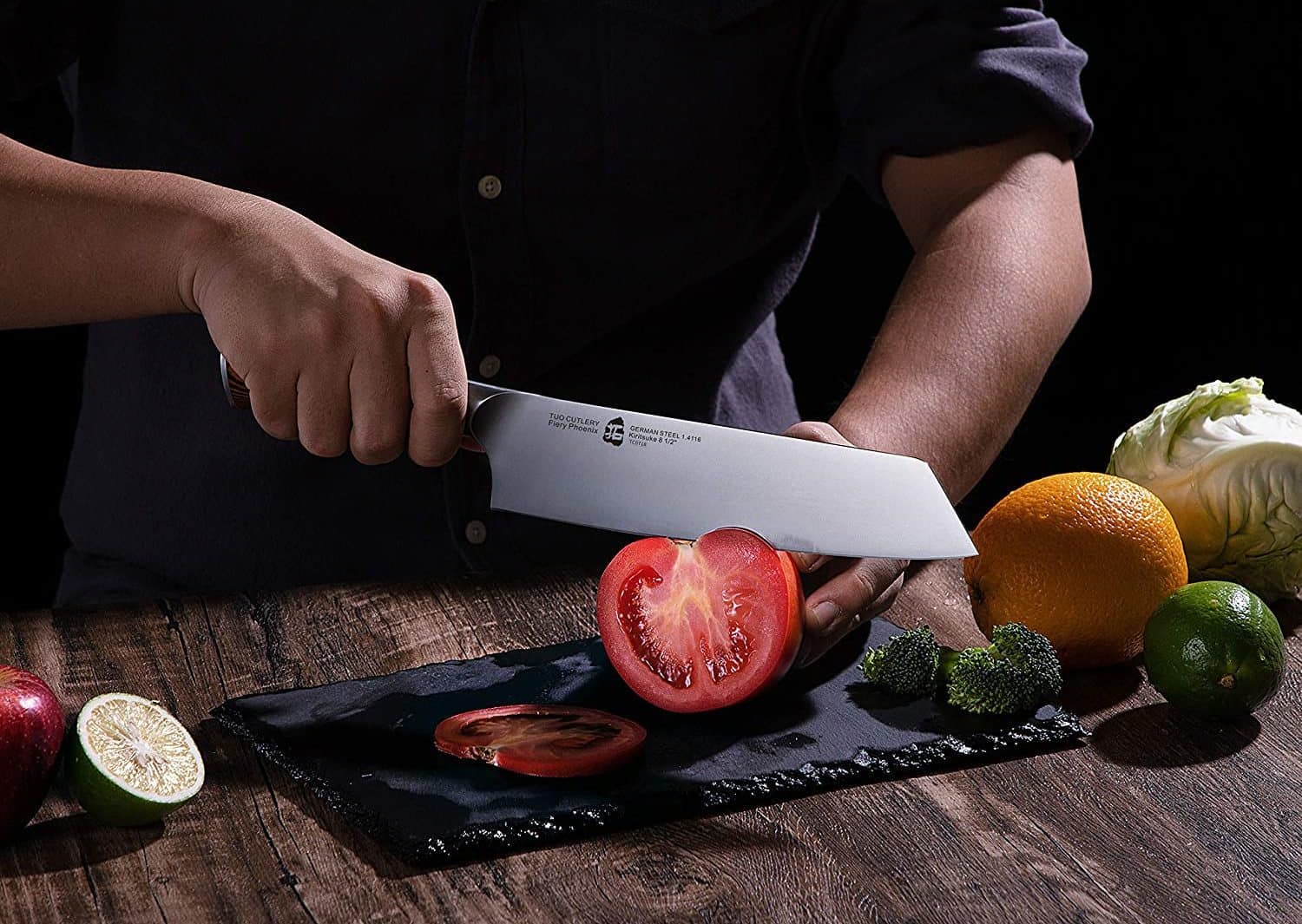
Compared to Calphalon knives, this one is actually much better and more durable. It’s sharper right out of the box and they can be used for precision cutting too. The sharp tip is handy for cutting meat from the bone.
This knife is well-balanced yet it still has a comfy lightweight handle so it doesn’t tire your hands out.
My main complaint is that the blade is actually made of German steel, not Japanese steel so it’s not quite as sharp as it could be – but for the price, it’s a great buy.
The TUO kiritsuke is also a great value for the price – you’re getting a high-quality, handmade Japanese knife at a fraction of the cost.
Takeaway
The best funayuki knives are handmade in Japan with a lot of care and precision.
These blades are made of high-quality stainless steel that is hand-sharpened to a razor’s edge, making them not only beautiful to look at but also great for use.
The MOTOKANE HONMAMON Funayuki is the kind of fish knife that does it all – from gutting to filleting for sashimi.
It has all the features you need and it’s made of real Japanese steel so you can expect it to be razor-sharp.
Now all you have to do is go on a fishing trip and try it out with the fresh catch!
Next, learn all about sushi-grade tuna fish, or Maguro (マグロ, 鮪, tuna in Japanese)
Check out our new cookbook
Bitemybun's family recipes with complete meal planner and recipe guide.
Try it out for free with Kindle Unlimited:
Read for freeJoost Nusselder, the founder of Bite My Bun is a content marketer, dad and loves trying out new food with Japanese food at the heart of his passion, and together with his team he's been creating in-depth blog articles since 2016 to help loyal readers with recipes and cooking tips.
